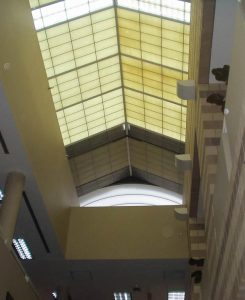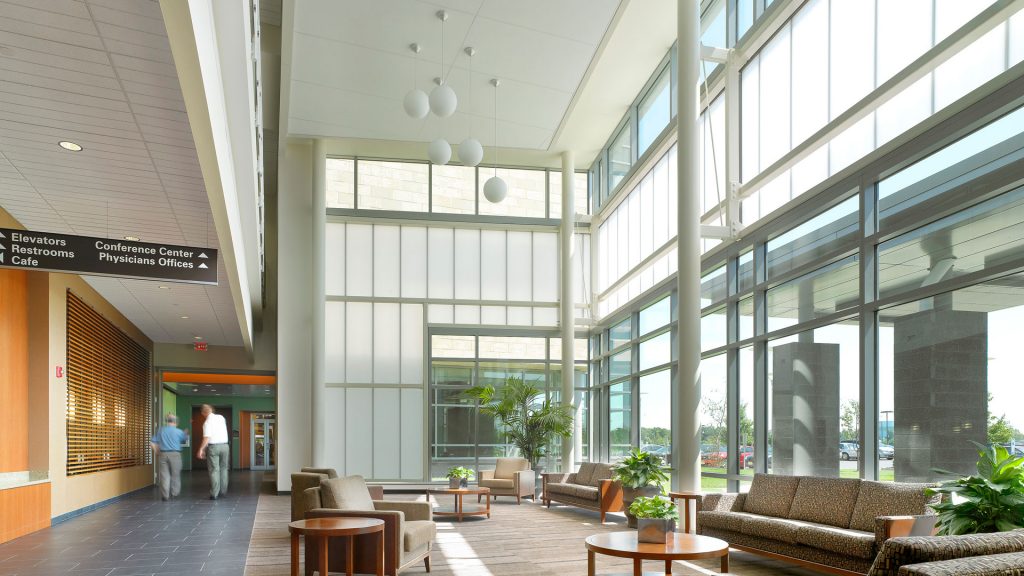
The amount of light skylights can provide depends directly on how much daylight is available outside.
Daylight Capacity
This varies with climatic conditions, the time of day and the season of the year. On a bright, sunny days, the maximum amount of daylight is very intense, on very dark rainy days, the light is soft and diffuse. Daylight is also seasonal and dependent on latitude, with the winter months providing less than 8 hours a day, while during the height of summer you can exceed over 16 hours a day.
Since our light sources in skylighting are the sun and sky, it is important to understand the different quantities and qualities of daylight available from each source, and how they vary with the climate and time of day. The specifics of your local climate will affect the optimum design of your skylights.
The proportion of cloudy days to clear blue days, and of direct beam sunlight to scattered skylight, in your local climate will determine how much illumination is available for sky-lighting.
Sunlight versus Skylight
Sunlight and skylight have very different physical properties and different effects in skylighting design. The term sky light includes the light from both clear blue and cloudy skies.
The most important differences are their intensity, their color, and the extent to which their light is scattered or diffused.
Sunlight
The sun is considered a point source of light, often referred to as beam sunlight, because it is completely directional. Sunlight is a very intense source of light, generally providing 5,000 to 10,000 foot-candles of illumination, though it varies with time of year and location on the planet. Sunlight also provides a warm color of light ranging from a warm candlelight color at sunrise and sunset, about 2000°K, to a more neutral color at noon of about 5500°K.
Cloudy Skylight
Light from the sky arrives from a large area and is more diffuse, i.e., scattered and arriving from all directions. Cloudy skies can be much brighter than clear blue skies. The brightness of cloudy skies depends largely on how thick the clouds are. The daylight on a day with complete cloud cover tends to create a very uniform lighting condition. Skylight from cloudy skies is warmer in color, a blend somewhere between sunlight and clear blue skies, at about 7,500°K.
Clear Skylight
Skylight from clear blue skies, on the other hand, is surprisingly non-uniform. It is darkest at 90° opposite the sun’s location, and brightest around the sun.
It also has a blue cast to it, and is characterized as a “cool” color temperature of up to 10,000°K.
Daylighting Impact
The mix of climate conditions should influence your choice of glazing materials, light well design and daylighting control strategies.
Glazing Materials
For example, a transparent skylight material may be acceptable in a mild cloudy climate (think Seattle), whereas a diffusing skylight is essential in areas with a significant number of sunny days (think Phoenix).
Daylighting Controls
Similarly, dimming controls may be more appropriate for areas with low daylight availability, while on/off controls may be acceptable in areas with predictably sunny weather.
Case Study | Duke Energy – Skylight Retrofit
9700 David Taylor Blvd
Charlotte, North Carolina 28201
Problem:
A very offensive smell was determined to be coming from failed fiberglass skylights. The building management installed an industrial exhaust fan in an attempt to remove the odors and the top floor of the Call Center was closed down to protect the health of the employees. Repairs were needed as soon as possible with little or no further disruption to the workforce.
Solution:
Working closely with management and CPI Daylighting, Skylight Specialists, Inc. installed a very unique solution that met all the requirements—including some special challenges:
- Acquiring all necessary licenses and building permits.
- Keeping the structure open to the workforce.
- Keeping the workforce safe and at bay.
- Coordinating manufacture, delivery, and installation within the shortest time possible.
The old skylight was removed in sections with a rubber membrane spanning the gap—maintaining a weather tight condition at all times—while the new skylight sections were installed. The Fastrak pre-assembled panelized systems, including pre-constructed vertical walls, allowed for quick on site construction with as little disruption to the building’s personnel as possible. This project was successfully completed within a three week time period.






